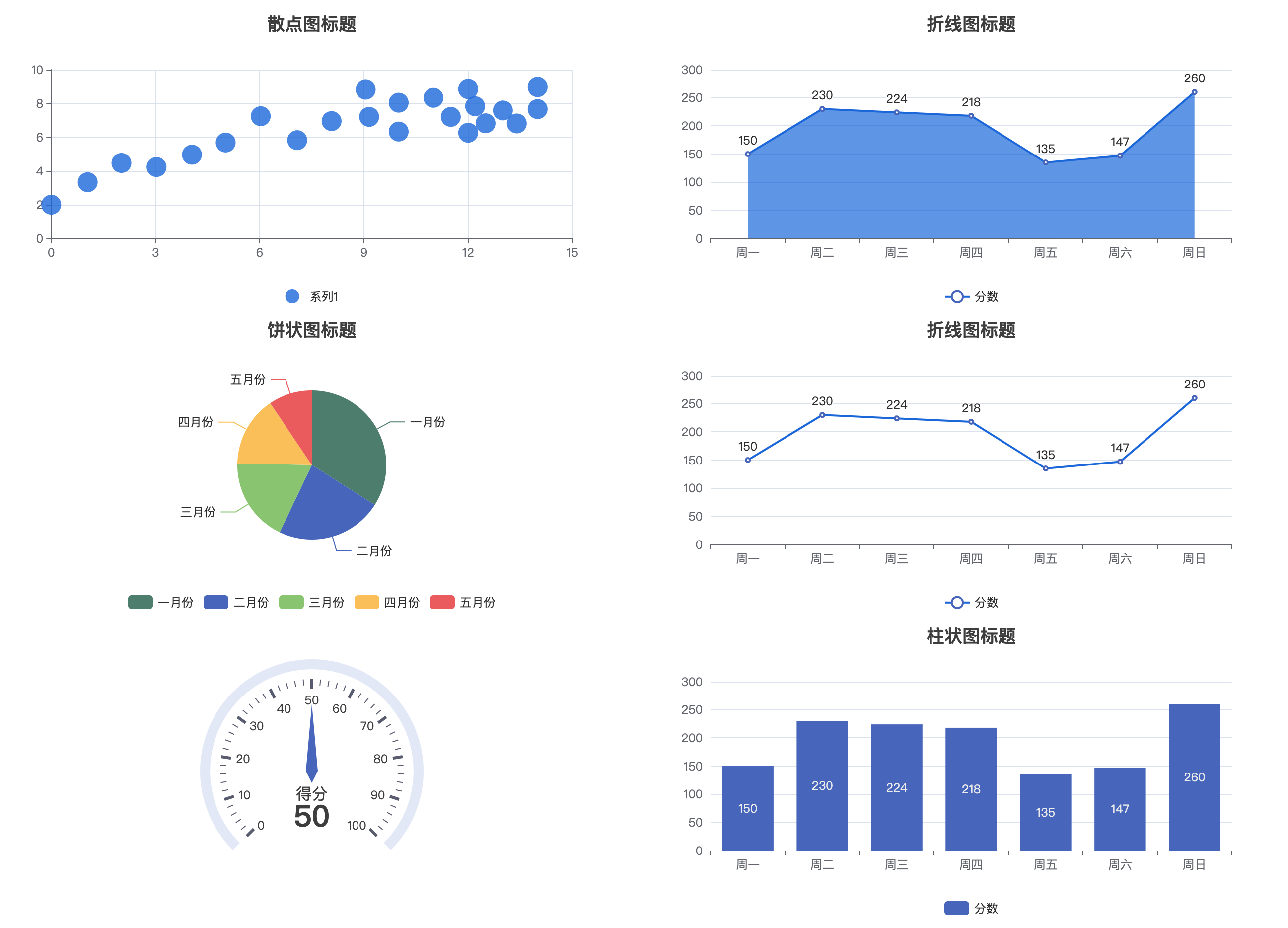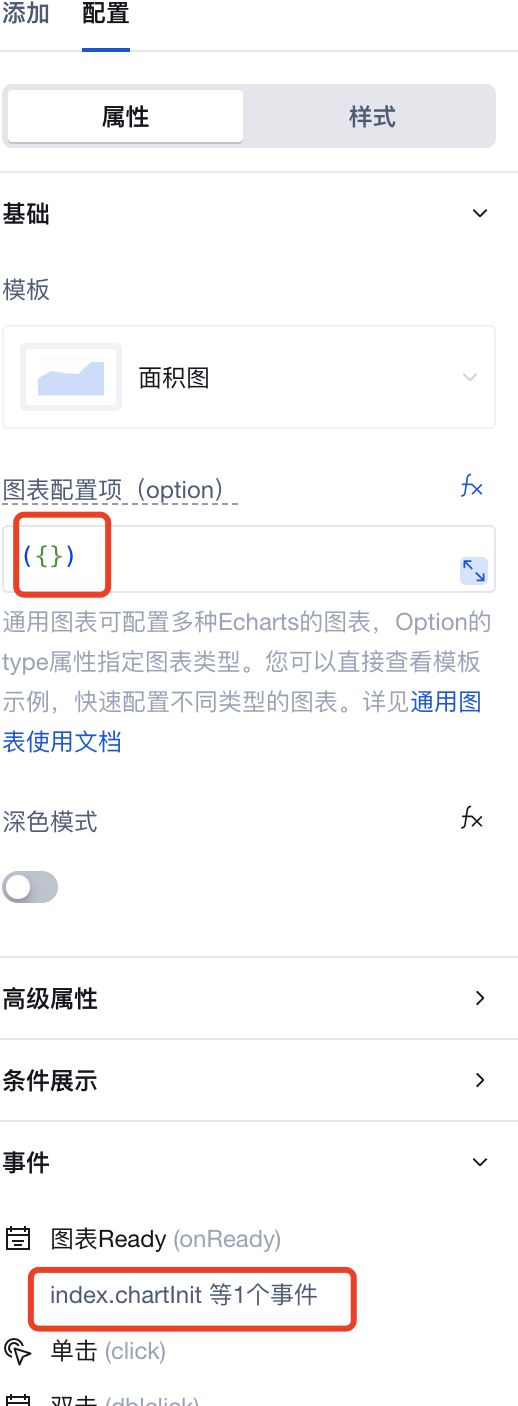More Charts
This is a versatile chart component capable of configuring various charts such as line charts, pie charts, area charts, maps, funnel charts, dashboards, and all other chart types. Using this component enables quick integration of all Echarts charts.
Applicable Scenarios
When the official component library's bar charts, line charts, and pie charts fall short of requirements, you can use this component.
Before using, please go to Echarts official website to browse chart examples to find the chart you need.
During use, directly configure Options to set chart data, styles, etc. You can also learn about configuration items through this document.

Basic Features
1. Template
This component provides several sets of commonly used chart templates, such as line charts, area charts, pie charts, etc.

2. Chart Configuration Items (Option)
You can also customize the Chart Configuration Items Option to instantly implement any chart. Navigate to the example configurations, copy the Option configuration object, and quickly implement your chart. As follows:
Below is a brief introduction to configuration items. For details, please visit the Echarts official website to learn and refer to the Echarts official configuration documentation.
Set Data
Data is primarily configured through xAxis and series, where series allows configuring multiple datasets, such as multiple lines in a line chart. See details.
xAxis: {
data: ['Mon', 'Tue', 'Wed', 'Thu', 'Fri', 'Sat', 'Sun'], // x-axis data
},
yAxis: {},
series: [
{
type: 'line', // type specifies the chart type, which can be set to line, pie, bar, etc.
// Chart Values
data: [150, 230, 224, 218, 135, 147, 260], // y-axis data
name: 'Series 1' // series name
}
]
Set Tags
Control chart labels via the label property. See details
label: {
show: true, // Whether to display
formatter: function(params){ // Custom label display
return params
}
},
To customize labels, refer to the formatting formatter function documentation
Set Title
Control chart title and position via the title property. See details
title: {
text: 'Chart Title',
x: '50%' // chart title position
}
Set Legend
Control chart title and position via the legend property. See details
Set Color Scheme
Set colors and styles for different series via lineStyle, itemStyle, and areaStyle in series. See details in Chart Custom Styles
series: [{
lineStyle: {
color: '#2A70E2',
width:'2',
type: 'solid'
},
itemStyle:{
color: 'auto',
},
areaStyle: {
color: '#2A70E2',
opacity: '0.5'
}
},{
lineStyle: {
color: '#2A70E2',
width:'2',
type: 'solid'
},
itemStyle:{
color: 'auto',
},
areaStyle: {
color: '#2A70E2',
opacity: '0.5'
}
}]
3. Initialize Chart Opts
Chart width, height, and other properties can be configured. See details in the opts configuration options for chart initialization init method
4. echart official website examples
Taking the official Flight Seat Selection example from echart as a reference, to implement this effect in WeiDa components, follow these steps:
1) "Create New javascript method" chartInit in Current Page

2) Define the "chartInit" method
Adapt from the echarts example and replace the corresponding component properties in the code: Replace echarts with $w.chart1.echarts, Replace myChart with $w.chart1.echartsInstance
export default async function ({ event, data }) {
const res = await fetch(
'https://lowcode-6g4bqrjy45e3e14b-1300677802.tcloudbaseapp.com/resources/2024-07/lowcode-1875317',
{
method: 'GET',
headers: {
'Content-Type': 'image/svg+xml'
}
}
);
const svg = await res.text();
$w.chart1.echarts.registerMap('flight-seats', { svg: svg });
const takenSeatNames = ['26E', '26D', '26C', '25D', '23C', '21A', '20F'];
const option = {
tooltip: {},
geo: {
map: 'flight-seats',
roam: true,
selectedMode: 'multiple',
layoutCenter: ['50%', '50%'],
layoutSize: '95%',
tooltip: {
show: true
},
itemStyle: {
color: '#fff'
},
emphasis: {
itemStyle: {
color: undefined,
borderColor: 'green',
borderWidth: 2
},
label: {
show: false
}
},
select: {
itemStyle: {
color: 'green'
},
label: {
show: false,
textBorderColor: '#fff',
textBorderWidth: 2
}
},
regions: makeTakenRegions(takenSeatNames)
}
};
function makeTakenRegions(takenSeatNames) {
var regions = [];
for (var i = 0; i < takenSeatNames.length; i++) {
regions.push({
name: takenSeatNames[i],
silent: true,
itemStyle: {
color: '#bf0e08'
},
emphasis: {
itemStyle: {
borderColor: '#aaa',
borderWidth: 1
}
},
select: {
itemStyle: {
color: '#bf0e08'
}
}
});
}
return regions;
}
$w.chart1.echartsInstance.setOption(option);
// Get selected seats.
$w.chart1.echartsInstance.on('geoselectchanged', function (params) {
const selectedNames = params.allSelected[0].name.slice();
// Remove taken seats.
for (var i = selectedNames.length - 1; i >= 0; i--) {
if (takenSeatNames.indexOf(selectedNames[i]) >= 0) {
selectedNames.splice(i, 1);
}
}
console.log('selected', selectedNames);
});
}
3) Set component properties and bind the "chartInit" function

Property Description
External properties received by the component
Property Name | Property Identifier | Type | Description |
|---|
| initialization parameter | opts | object | For Echarts chart configuration, see configure project Example: {} |
| Template | template | string | System preset template Can be used to select different templates for quick configuration of required chart types Example: "square" |
| Chart configuration options | option | object | For Echarts chart configuration, see configure project Example: {} |
| dark mode | dark | boolean | Example: false |
Event Description
Events exposed by the component. You can listen to component events to trigger external actions
Event Name | Event Code | Event Output Parameters event.detail | Applicable Scenarios | Description |
|---|
| Chart Ready | onReady | object
| Compatible with all platforms | The current chart has completed instance initialization. |
| click | click | Mobile,PC | This method is triggered when a coordinate point in the graph is clicked. For details, see [Echarts Official Event Description](echarts.apache.org/zh/api.html#events.% E9%BC%A0%E6%A0%87%E4%BA%8B%E4%BB%B6.click) | |
| double-click | dblclick | Mobile,PC | Double-click A coordinate point in the chart to trigger this method. See the Echarts official event description for details. |
Properties API
Through the Property API, you can access the internal state and property values of components. You can access internal values using$w.componentId.propertyName, such as $w.input1.value. For details, please refer to Property API
Read-only Property Name | Property Identifier | Type | Description |
|---|
| Chart instance | echartsInstance | object | Chart operations can be performed through the chart instance. For specific operation content, see the official documentation from Echarts. |
| echarts object | echarts | object | This is equivalent to directly introducing echarts into the project. You can directly call its internal methods through the echarts object to perform corresponding operations, such as echarts.color, echarts.graphic, etc. For details, see Official Description of Echarts. |
Method API
Through the Method API, you can programmatically trigger internal methods of components, such as submitting forms, displaying popups, etc. You can call component methods using $w.componentId.methodName, such as $w.form1.submit()
Method Name | Method Identifier | Parameters | Method Description |
|---|
| Configure charts | setOption | object
| Set the configuration item and data of a chart instance. The versatile api allows ALL parameter and data modification through setOption. You can directly view the official Echarts illustrative example. |
| Set topic | setTheme | object
| Set the theme of the chart instance. Different types of themes are supported, with dart and auto as defaults. You can also register a theme through the registerTheme method officially provided by Echarts. |
Style API
Through the Style API, you can override the styles of internal elements in components to achieve customization. For example, in the low-code editor, you can write styles for all button components using #wd-page-root .wd-btn, and control individual component styles with :scope. For detailed instructions, please refer toStyle API
Name | Class Name | Description and Examples |
|---|
| root element | .wd-chart | tree component root element |
| PC-side root element | .wd-pc-chart | Write styles for PC |
| H5 root element | .wd-h5-chart | Write style for H5 |
Frequently Asked Questions
Relationship Between Chart Component and Universal Chart Component
- The Universal Chart component is a versatile chart component capable of configuring various charts such as line charts, pie charts, area charts, maps, funnel charts, dashboards, and all other chart types. Using this component enables quick integration of all Echarts charts.
- The UI configuration of the Universal Chart component is more flexible, supporting virtually all common chart types.
- The Universal Chart component itself is data-agnostic. Data statistics can be achieved through Query, where data aggregation is performed via APIs or the MySQL connector, and then bound to the Universal Chart component.